Given Phar lap’s success, you could say generational breeding is a potent way of building an athlete. For cars, too, we’ve seen such genetic refinement benefit thoroughbreds like Porsche’s 911.
But what about where mister middle class lives? In a world where baby seats are a reality and the ever humble hot-hatch is the best solution, has today’s top dog evolved over generations like Volkwagen’s Golf R, or is the formula simple enough to be nailed first go by Audi’s S1 Sportback?
And while, yes, they live segments apart within a rich hot-hatch ecosystem, only these two offer a ticket to luxury, all-weather performance, and four-dour hatch practicality while still being within spitting distance of $50K.
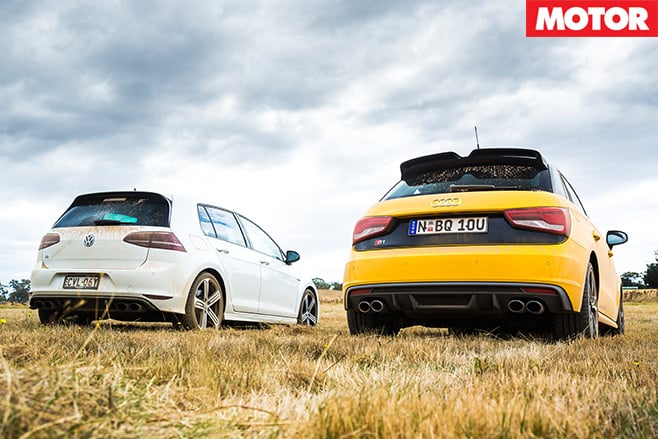
Then again, Audi can claim a similar depth of knowledge when it comes to boosted all-paw performance. And while Audi’s new S1 Sportback can’t boast direct relation to anything before it besides the A1 Clubsport Quattro concept, its badge is shared with one of the most iconic rally cars of WRC’s Group B era, the flame-throwing Quattro S1, which is promising.
Rather than a by-product of motorsport regulation, today’s Golf R is the spiciest iteration of VW’s evergreen hatch, now in its seventh-generation. Wolfsburg’s managed to carve 45kg from the Mk VII’s platform, an act which is complemented by a leaner looking exterior, as the R’s gaping bumper design, peaked crease lines, and aggressive headlight shape evaporate any fat from the previous model’s look.
R-specific silver mirrors, standard 19s and rear LED lights further sophisticate the package, such that if you were to relate it to jungle wildlife the Golf R would be a panther: relatively stealth, but an impressive athlete up close.

What it lacks in size, however, it makes up for in flair, especially when every option ticked on our test car helps ramp up its attitude. There’s the black roof dome and boot lid insert, both individual options, that when contrasted against our S1’s retina-searing ‘vegas’ yellow paintjob it’s obvious which of these two suits the extrovert.
This outgoing personality is further cemented by the ‘quattro exterior package’ that throws in quattro door stickers, 18s, a roof spoiler, red calipers, aluminium finish on the front lip and sexy red eyeliner for the Xenon headlights. Such flamboyance continues inside.
The ‘quattro interior package’ summons a yellow centre console, matched to seat shells in the same hue, while red rings appear within the (again) optional aluminium vents and yellow stitching on the leather.

Meanwhile, the VW fails to feel as sophisticated as the Audi, despite leather and aluminium on its touchpoints, and the dull grey cloth/alcantara seats highlight that. The demure personality also extends to its options list, with leather and a sunroof being the only way to add more class to the cabin.
But that’s not to say VW doesn’t deliver a fantastic helm. It shines more in areas like ergonomics and expected equipment. Unlike the Audi, the Golf brings to the table auto-wipers, -lights and a reversing camera, while the seats feature a superbly placed hip point that’s low and close to the wheel.
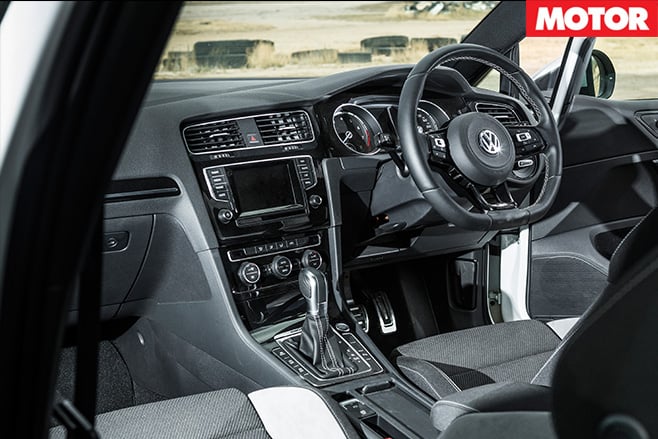
VW’s EA888, which also serves duty in the GTI, has undergone changes to elevate its potency in ‘R’ form, as exclusive pistons, exhaust valve components and injection valves mean it’s good for 221kW, just not while slurping Oz fuel.
Audi also uses the EA888 in its S3, however the engine was detuned before being shoehorned into the S1, where use of a smaller turbocharger (but more boost) yields 170kW and 370Nm. The outputs are down on the Golf’s, but torque materialises sooner and propels 95kg less.
While lighter, the S1’s no bantamweight. Both cars employ a Haldex-enabled all-wheel drive system to distribute power between the front and rear axle, except in order to make the system fit in its S1 Audi had to employ the S3’s multi-link rear suspension, swap the space saver for a repair kit, and re-design the fuel tank to accommodate a differential and propshaft down the car’s centre. In effect, Audi ditched the idea of a dual-clutch automatic to avoid further weight penalty.
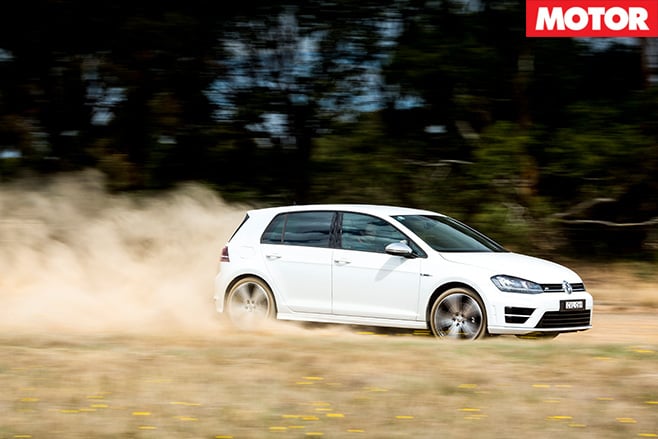
This hurts the brightly coloured mite nowhere more than Heathcote Raceway’s start line, where it’s up to you rather than electronics to perfect its launch. However, reaping the best from its 4000rpm limit in neutral will disappoint mechanical sympathisers: slip the clutch too slowly and it’ll crawl off line, whereas being more forceful sees it bog.
Experimentation quicklys narrows down the best launch technique to loading the car up against its handbrake before slipping the clutch in with a swift but controlled lift of your left leg. Nail it and the S1 glides forward, its superior grip helping quell any tramp from either axle, before racing through to its 6500rpm red zone.
Paired to a suite of fast gearchanges the S1 will smash its claimed times and register a 5.68sec charge to 100km/h and 13.89sec at 162.38 clicks over the quarter mile. Figures that other cars the S1’s size could only fantasise about, but more than in reach for the VW.
On the other hand the Golf R’s launch control is so easy the process could join primary school curriculum. Find the Adaptive Chassis Control system’s Race mode and switch off traction control, bring the Golf to a stop, load the anchors with your left foot and throttle with your right, then step off the brake pedal.
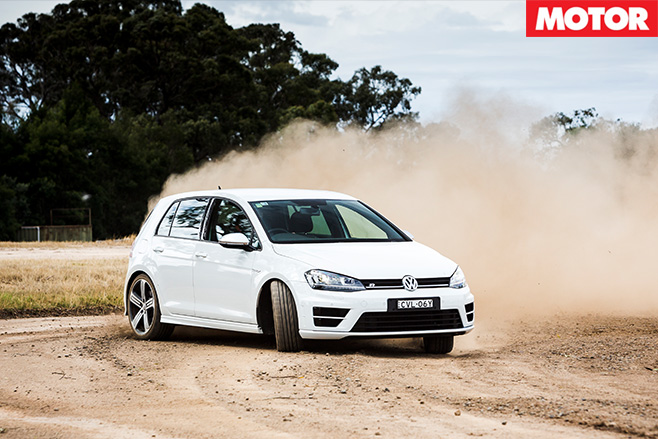
In that first split second to 10 clicks the Audi’s lithe weight gifts it an initial advantage, but from there the Golf’s wider footprint, more rear biased four-paw system and bullet fast dual-clutch help it bury the S1 before the first gearshift. And you could swig a Pepsi while doing it. Such grace isn’t only limited to the dragstrip. Breaking free for open Victorian roads shows that the Golf R is just as stoic flowing across country.
It’s at this point you suspect Volkswagen pays its suspension engineers in gold bricks, because the way the Golf’s damping absorbs the pimpled geometry of Australian tarmac is nothing short of superb for such money.
Rude compressions feel thwarted by clouds rather than bump stops, meanwhile there seems to be so much suspension travel you’d swear the dampers are housed in bell towers. The fact the Golf wears 35-profile 19s only adds further to the bewilderment.
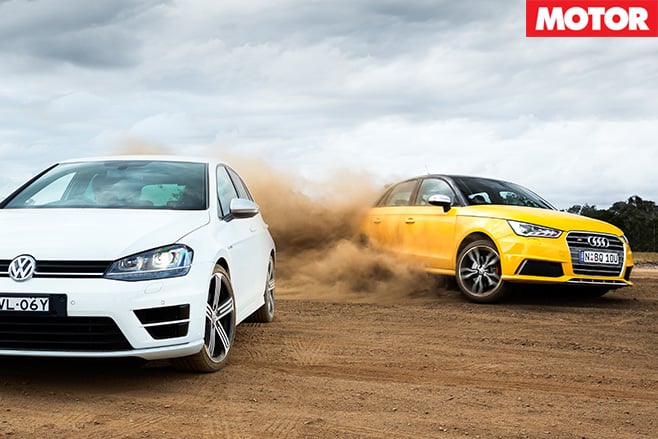
But that isn’t the only credit to the Audi. Its more favourable torque-to-weight ratio means it can sit in taller gears, its healthy mid-range feeling accessible from as low as 2700rpm. Thrust doesn’t arrive as early in the Golf R, but when it does arrive there’s more of it, and a stronger rush to redline. You’ll also hang outside a B-double for less time in the Golf, its 80-120km/h time proving almost five tenths quicker at 3.1sec.
At full noise, you’d pick the Golf’s theatrics as a more dramatic experience. There’s a trace of turbocharger whistle in the cabin that chimes in above a gruff rumble that’s plumbed in to the cabin.
It’s likeable, and certainly cool, but to us the Audi sounds more authentic, even if it may not be. Digging deep in the S1’s throttle opens exhaust flaps to play a waspy blat from its quad tips, while the cabin fills with a rorty amplified note from an intake tract.
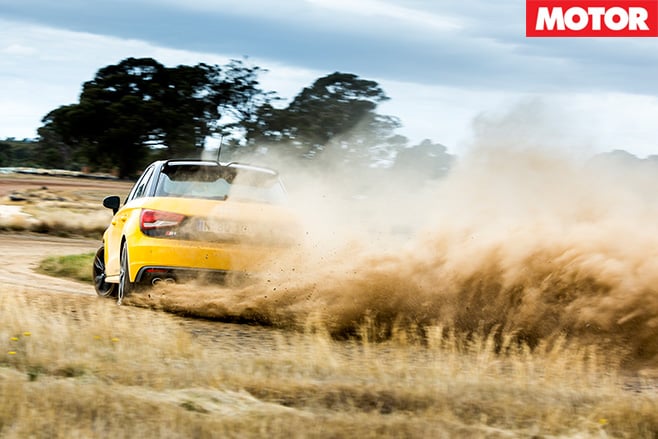
The Golf is more clinical, but what it lacks in involvement is made up for in speed. Despite having almost exactly the same weight distribution as the Audi it’s more balanced and neutral thanks to its longer wheelbase and wider tracks. As pace increases it’s this more effective spread of grip that makes it better at channelling energy into forward pace. The Audi simply can’t keep up.
Nor can its steering match the Golf’s for directness, weight and accuracy. Its brakes, too, are a little softer. Their disparate personalities are further defined on the highway. Both work equally as hard at 110km/h, the Audi turning its engine at 2625rpm in sixth gear, the Volkswagen at 100rpm less, but it’s the Golf that covers the distance in the most relaxed state.
Against a crosswind the Veedub floats over pockmarked distances with wonderful directional stability. Meanwhile you’re inside, enjoying the decent-sized cabin as the damping and bigger seats ease you in to a rhythm for slicing through slower traffic.
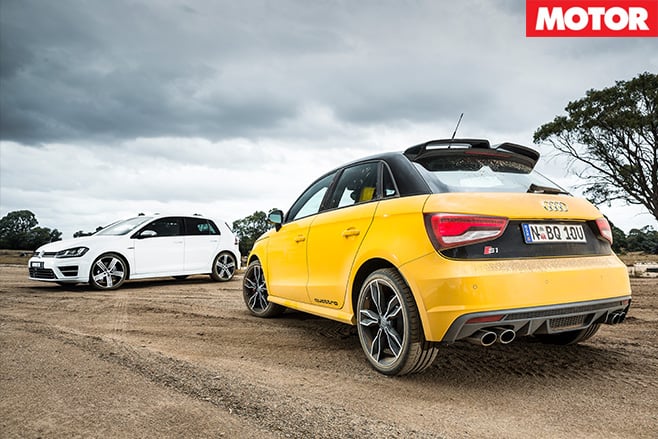
All of which contributes to why the Audi’s our number two. Both are fantastic cars. And from its extroverted appearance to extensive engineering, the S1 is interesting, fast, and blazes a new path in its own supermini segment. It’s a hoot, but MOTOR wonders what sort of animal a full-stick 206kW EA888 would have created of the S1?
Nonetheless, its good-time personality pales in comparison to the abilities of the VW, whether at the strip, mountain pass, highway or in gridlock. The fact they share mechanical organs only highlights the Golf R’s more developed package. And in the end, it’s the Audi S1’s untapped potential that proves hot-hatch greatness here is developed over time, or in VW’s case, over generations.






